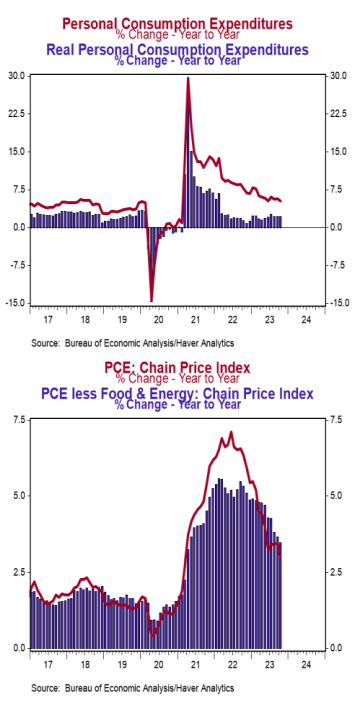- Personal income rose 0.3% in December, matching consensus expectations. Personal consumption rose 0.7% in December (+0.8% including revisions to prior months), beating the consensus expected +0.5%. Personal income is up 4.7% in the past year, while spending has increased 5.9%.
- Disposable personal income (income after taxes) rose 0.3% in December and is up 6.9% from a year ago.
The overall PCE deflator (consumer prices) rose 0.2% in December and is up 2.6% versus a year ago. The “core” PCE deflator, which excludes food and energy, also rose 0.2% in December and is up 2.9% in the past year.
- After adjusting for inflation, “real” consumption rose 0.5% in December and is up 3.2% from a year ago.
Implications: Today’s report on the consumer shows no signs of recession and more improvement in inflation. Personal income rose 0.3% in December. Private wages and salaries were up 0.3% in December and up 6.5% in the past year. Meanwhile, government pay was up 0.7% in December and is up 8.2% in the past year, the most for any year in the past three decades. We don’t think the growth in government pay is sustainable or good for the overall US economy. Consumer spending rose 0.7% in December, with both goods and services showing gains. Outlays on goods rose 0.9% in December, the largest single month gain since last January, as consumers picked up spending on autos and prescription drugs. Goods spending is up 5.0% in the past year (and with goods inflation flat, spending is up 5.0% in the past year when adjusted for inflation). Spending on services rose 0.6% in December - led by financial services and insurance - and is up 6.3% in the past year (2.3% when adjusted for inflation). On the inflation front, PCE prices – the Federal Reserve’s preferred measure of inflation – were up 0.2% in December, bringing the twelve-month comparison to 2.6%, versus 5.4% in the twelve months ending in December 2022. “Core” prices, which exclude the ever-volatile food and energy categories, also rose 0.2% in December and are up 2.9% versus a year ago. That’s down from 4.9% in the year ending in December 2022. Note that the Fed has prioritized a subset of inflation dubbed the “Super Core,” which is services only (no goods), excluding food, energy, and housing. That measure rose 0.3% in December and is up 3.3% versus a year ago. That’s an improvement versus the 4.8% increase in the year ending in December 2022, but not as much improvement than the overall figure or core. In addition, all these measures remain above the Fed’s 2.0% target and given shipping disruptions in the Red Sea that are delaying deliveries and pushing up shipping costs, we would not be surprised to see volatility in the inflation numbers in the months ahead. It’s too early to call victory, but the data are trending in the right direction.





